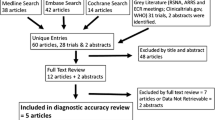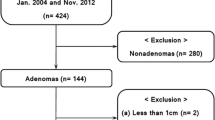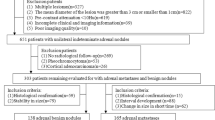Abstract
Objectives
To investigate usefulness of biphasic computed tomography (CT) in characterizing hyperattenuating adrenal lesions in lung cancer.
Methods
This retrospective study included 239 patients with lung cancer who underwent adrenal CT for hyperattenuating (> 10 Hounsfield unit) adrenal lesions. Adrenal CT comprised unenhanced and 1-min and 15-min enhanced images. We dichotomized adrenal lesions depending on benign or metastatic lesions. Reference standard for benignity was histologic confirmation or ≥ 6-month stability on follow-up CT. Two independent readers analyzed absolute (APW) or relative percentage wash-out (RPW) using triphasic CT, and enhancement ratio (ER) or percentage wash-in (PWI) using biphasic CT (i.e., unenhanced and 1-min enhanced CT). Criteria for benignity were as follows: criteria 1, (a) APW ≥ 60% or (b) RPW ≥ 40%, and criteria 2, (a) ER > 3 and (b) PWI > 200%. We analyzed area under the curve (AUC) and accuracy for benignity, and inter-reader agreement.
Results
Proportion of benign adrenal lesion was 71.1% (170/239). For criteria 1 and 2, AUCs were 0.872 (95% confidence interval [CI], 0.822–0.911) and 0.886 (95% CI, 0.838–0.923), respectively, for reader 1 (p = 0.566) and 0.816 (95% CI, 0.761–0.863) and 0.814 (95% CI, 0.759–0.862), respectively, for reader 2 (p = 0.955), and accuracies were 87.9% (210/239) and 86.2% (206/239), respectively, for reader 1 (p = 0.479) and 81.2% (194/239) and 80.3% (192/239), respectively, for reader 2 (p = 0.763). Weighted kappa was 0.725 (95% CI, 0.634–0.816) for criteria 1 and 0.736 (95% CI, 0.649–0.824) for criteria 2.
Conclusion
Biphasic CT can reliably characterize hyperattenuating adrenal lesions in patients with lung cancer.
Key Points
• Criteria from biphasic computed tomography (CT) for diagnosing benign adrenal lesions were enhancement ratio of > 3 and percentage wash-in of > 200%.
• In the analysis by two independent readers, area under the curve between criteria 1 and 2 was not significantly different (0.872 and 0.886 for reader 1; 0.816 and 0.814, for reader 2; p > 0.05 for each comparison).
• Wash-in characteristics from biphasic CT are helpful to predict benign adrenal lesions in lung cancer.





Similar content being viewed by others
Abbreviations
- APW:
-
Absolute percentage wash-out
- CECT:
-
Contrast-enhanced computed tomography
- CT:
-
Computed tomography
- ER:
-
Enhancement ratio
- FDG:
-
Fluorodeoxyglucose
- HU:
-
Hounsfield unit
- LOESS:
-
Locally estimated scatterplot smoothing
- NPV:
-
Negative predictive value
- PET:
-
Positron emission tomography
- PPV:
-
Positive predictive value
- PWI:
-
Percentage wash-in
- ROI:
-
Region of interest
- RPW:
-
Relative percentage wash-out
- UCT:
-
Unenhanced computed tomography
References
Riihimaki M, Hemminki A, Fallah M et al (2014) Metastatic sites and survival in lung cancer. Lung Cancer 86:78–84
Oikawa A, Takahashi H, Ishikawa H, Kurishima K, Kagohashi K, Satoh H (2012) Application of conditional probability analysis to distant metastases from lung cancer. Oncol Lett 3:629–634
Expert Panel on Thoracic Imaging, de Groot PM, Chung JH et al (2019) ACR Appropriateness Criteria((R)) noninvasive clinical staging of primary lung cancer. J Am Coll Radiol 16:S184–S195
Cohen SL, Ward TJ, Cham MD (2020) The relationship between CT scout landmarks and lung boundaries on chest CT: guidelines for minimizing excess z-axis scan length. Eur Radiol 30:581–587
Detterbeck FC, Boffa DJ, Kim AW, Tanoue LT (2017) The eighth edition lung cancer stage classification. Chest 151:193–203
Elsayes KM, Emad-Eldin S, Morani AC, Jensen CT (2017) Practical approach to adrenal imaging. Radiol Clin North Am 55:279–301
Remer EM, Obuchowski N, Ellis JD, Rice TW, Adelstein DJ, Baker ME (2000) Adrenal mass evaluation in patients with lung carcinoma: a cost-effectiveness analysis. AJR Am J Roentgenol 174:1033–1039
Johnson PT, Horton KM, Fishman EK (2009) Adrenal mass imaging with multidetector CT: pathologic conditions, pearls, and pitfalls. Radiographics 29:1333–1351
Boland GW, Dwamena BA, Jagtiani Sangwaiya M et al (2011) Characterization of adrenal masses by using FDG PET: a systematic review and meta-analysis of diagnostic test performance. Radiology 259:117–126
Fischer B, Lassen U, Mortensen J et al (2009) Preoperative staging of lung cancer with combined PET-CT. N Engl J Med 361:32–39
Vikram R, Yeung HD, Macapinlac HA, Iyer RB (2008) Utility of PET/CT in differentiating benign from malignant adrenal nodules in patients with cancer. AJR Am J Roentgenol 191:1545–1551
Young WF Jr (2007) Clinical practice. The incidentally discovered adrenal mass. N Engl J Med 356:601–610
Mayo-Smith WW, Song JH, Boland GL et al (2017) Management of incidental adrenal masses: a white paper of the ACR Incidental Findings Committee. J Am Coll Radiol 14:1038–1044
Schieda N, Siegelman ES (2017) Update on CT and MRI of Adrenal Nodules. AJR Am J Roentgenol 208:1206–1217
Koo HJ, Choi HJ, Kim HJ, Kim SO, Cho KS (2014) The value of 15-minute delayed contrast-enhanced CT to differentiate hyperattenuating adrenal masses compared with chemical shift MR imaging. Eur Radiol 24:1410–1420
Platzek I, Sieron D, Plodeck V, Borkowetz A, Laniado M, Hoffmann RT (2019) Chemical shift imaging for evaluation of adrenal masses: a systematic review and meta-analysis. Eur Radiol 29:806–817
Ho LM, Samei E, Mazurowski MA et al (2019) Can texture analysis be used to distinguish benign from malignant adrenal nodules on unenhanced CT, contrast-enhanced CT, or in-phase and opposed-phase MRI? AJR Am J Roentgenol 212:554–561
Shi B, Zhang GM, Xu M, Jin ZY, Sun H (2019) Distinguishing metastases from benign adrenal masses: what can CT texture analysis do? Acta Radiol 60:1553–1561
Foti G, Faccioli N, Manfredi R, Mantovani W, Mucelli RP (2010) Evaluation of relative wash-in ratio of adrenal lesions at early biphasic CT. AJR Am J Roentgenol 194:1484–1491
Boland GW (2010) Adrenal imaging: why, when, what, and how? Part 1. Why and when to image? AJR Am J Roentgenol 195:W377–W381
Boland GW, Blake MA, Hahn PF, Mayo-Smith WW (2008) Incidental adrenal lesions: principles, techniques, and algorithms for imaging characterization. Radiology 249:756–775
Pena CS, Boland GW, Hahn PF, Lee MJ, Mueller PR (2000) Characterization of indeterminate (lipid-poor) adrenal masses: use of washout characteristics at contrast-enhanced CT. Radiology 217:798–802
Yun M, Kim W, Alnafisi N, Lacorte L, Jang S, Alavi A (2001) 18F-FDG PET in characterizing adrenal lesions detected on CT or MRI. J Nucl Med 42:1795–1799
Chong S, Lee KS, Kim HY et al (2006) Integrated PET-CT for the characterization of adrenal gland lesions in cancer patients: diagnostic efficacy and interpretation pitfalls. Radiographics 26:1811–1824 discussion 1824-1816
Kumar R, Xiu Y, Yu JQ et al (2004) 18F-FDG PET in evaluation of adrenal lesions in patients with lung cancer. J Nucl Med 45:2058–2062
Blake MA, Singh A, Setty BN et al (2006) Pearls and pitfalls in interpretation of abdominal and pelvic PET-CT. Radiographics 26:1335–1353
Delong ER, Delong DM, Clarkepearson DI (1988) Comparing the areas under 2 or more correlated receiver operating characteristic curves - a nonparametric approach. Biometrics 44:837–845
Wang W, Davis CS, Soong SJ (2006) Comparison of predictive values of two diagnostic tests from the same sample of subjects using weighted least squares. Stat Med 25:2215–2229
Leisenring W, Alonzo T, Pepe MS (2000) Comparisons of predictive values of binary medical diagnostic tests for paired designs. Biometrics 56:345–351
Jakobsson U, Westergren A (2005) Statistical methods for assessing agreement for ordinal data. Scand J Caring Sci 19:427–431
Mukaka MM (2012) Statistics corner: a guide to appropriate use of correlation coefficient in medical research. Malawi Med J 24:69–71
Cleveland WS, Devlin SJ (1988) Locally weighted regression - an approach to regression-analysis by local fitting. J Am Stat Assoc 83:596–610
Boland GW (2011) Adrenal imaging: why, when, what, and how? Part 2. What technique? AJR Am J Roentgenol 196:W1–W5
Szolar DH, Kammerhuber FH (1998) Adrenal adenomas and nonadenomas: assessment of washout at delayed contrast-enhanced CT. Radiology 207:369–375
Garcia-Garrigos E, Arenas-Jimenez JJ, Sanchez-Paya J (2018) Best protocol for combined contrast-enhanced thoracic and abdominal CT for lung cancer: a single-institution randomized crossover clinical trial. AJR Am J Roentgenol 210:1226–1234
Connolly MJ, McInnes MDF, El-Khodary M, McGrath TA, Schieda N (2017) Diagnostic accuracy of virtual non-contrast enhanced dual-energy CT for diagnosis of adrenal adenoma: a systematic review and meta-analysis. Eur Radiol 27:4324–4335
Han WK, Na JC, Park SY (2020) Low-dose CT angiography using ASiR-V for potential living renal donors: a prospective analysis of image quality and diagnostic accuracy. Eur Radiol 30:798–805
Greffier J, Hamard A, Pereira F et al (2020) Image quality and dose reduction opportunity of deep learning image reconstruction algorithm for CT: a phantom study. Eur Radiol 30:3951–3959
Blake MA, Cronin CG, Boland GW (2010) Adrenal imaging. AJR Am J Roentgenol 194:1450–1460
Adams MC, Turkington TG, Wilson JM, Wong TZ (2010) A systematic review of the factors affecting accuracy of SUV measurements. AJR Am J Roentgenol 195:310–320
Acknowledgments
This study was supported by Samsung Medical Center Grant (SMO1190081).
We would like to thank Editage (www.editage.co.kr) for English language editing.
Funding
This study was supported by Samsung Medical Center Grant (SMO1190081).
Author information
Authors and Affiliations
Corresponding author
Ethics declarations
Guarantor
The scientific guarantor of this publication is Sung Yoon Park, M.D.
Conflict of interest
The authors of this manuscript declare no relationships with any companies whose products or services may be related to the subject matter of the article.
Statistics and biometry
No complex statistical methods were necessary for this paper.
Informed consent
Written informed consent was waived by the Institutional Review Board.
Ethical approval
Institutional Review Board approval was obtained.
Methodology
• retrospective
• cross sectional study
• performed at one institution
Additional information
Publisher’s note
Springer Nature remains neutral with regard to jurisdictional claims in published maps and institutional affiliations.
Supplementary Information
ESM 1
(DOC 1815 kb)
Rights and permissions
About this article
Cite this article
Lee, H.Y., Oh, Y.L. & Park, S.Y. Hyperattenuating adrenal lesions in lung cancer: biphasic CT with unenhanced and 1-min enhanced images reliably predicts benign lesions. Eur Radiol 31, 5948–5958 (2021). https://doi.org/10.1007/s00330-020-07648-1
Received:
Revised:
Accepted:
Published:
Issue Date:
DOI: https://doi.org/10.1007/s00330-020-07648-1




